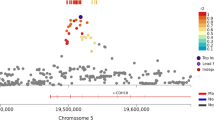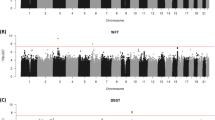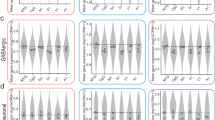Abstract
The presence of genetic influences on cognitive performance and brain volume is well established. However, specific genetic determinants of the variance of these quantitative traits are not yet known. Plexins act as receptors for semaphorins and are implicated in axon guidance, which is a key process in brain development. We have previously shown that plexin B3 is a highly potent stimulator of neurite outgrowth, which makes its gene PLXNB3 an intriguing candidate gene for traits related to human brain development and cerebral connectivity. We identified several polymorphisms in PLXNB3 predicting changes of amino acids (V598I, E1156D and V1596E) conserved at the corresponding positions of the orthologs in mouse and chimpanzee. PLXNB3 was genotyped in 303 healthy volunteers and 42 male patients with schizophrenia. Cognitive performance was measured with the vocabulary test (Wortschatztest (WST)), a method to estimate roughly general intelligence (g). Brain morphology was characterized by magnetic resonance imaging. Compared to subjects not carrying the modern, human-specific haplotype A, carriers of A scored higher in vocabulary test (WST) irrespective of diagnosis (P=0.0004). This effect could be observed in three independent groups (healthy males: P=0.048; schizophrenic males: P=0.034 and healthy females: P=0.037). Additionally, the haplotype A was associated with increased volume of brain white matter that in turn correlated with performance in the vocabulary test. These findings suggest that plexin B3 may influence cognitive performance, and the development of white matter in vivo in a way similar to its known stimulating effect on neurite outgrowth in vitro. These novel observations warrant further replication in independent samples.
This is a preview of subscription content, access via your institution
Access options
Subscribe to this journal
Receive 12 print issues and online access
$259.00 per year
only $21.58 per issue
Buy this article
- Purchase on Springer Link
- Instant access to full article PDF
Prices may be subject to local taxes which are calculated during checkout

Similar content being viewed by others
References
Plomin R, Petrill S . Genetics and intelligence: what's new? Intelligence 1997; 24: 53–77.
Bouchard TJ . Genetic and environmental influences on adult intelligence and special mental abilities. Hum Biol 1998; 70: 257–279.
Baare WF, Hulshoff Pol HE, Boomsma DI, Posthuma D, de Geus EJ, Schnack HG et al. Quantitative genetic modeling of variation in human brain morphology. Cereb Cortex 2001; 11: 816–824.
Vernon PA, Wickett JC, Banzana PG, Stelmack RM. In: Sternberg RJ (ed). Handbook of Intelligence. University Press: Cambridge, 2000, pp 245–264.
Plomin R, Kosslyn SM . Genes, brain and cognition. Nat Neurosci 2001; 4: 1153–1154.
Posthuma D, De Geus EJ, Baare WF, Hulshoff Pol HE, Kahn RS, Boomsma DI . The association between brain volume and intelligence is of genetic origin. Nat Neurosci 2002; 5: 83–84.
Tamagnone L, Artigiani S, Chen H, He Z, Ming GI, Song H et al. Plexins are a large family of receptors for transmembrane, secreted, and GPI-anchored semaphorins in vertebrates. Cell 1999; 99: 71–80.
Hartwig C, Veske A, Krejcova S, Rosenberger G, Finckh U . Plexin B3 promotes neurite outgrowth, interacts homophilically, and interacts with Rin. BMC Neurosci 2005; 25: 53.
Schmidt KH, Metzler P . Wortschatztest (WST). Beltz Test: Weinheim, Germany, 1992.
Tewes U . HAWIE-R Hamburg-Wechsler Intelligenztest für Erwachsene, Revision. Hogrefe: Goettingen, Germany, 1991.
Satzger W, Fessmann H, Engel RR . Liefern HAWIE-R, WST und MWT-B vergleichbare IQ-Werte? Zeitschrift für Diff und Diag Psy 2002; 23: 159–170.
Meisenzahl EM, Rujescu D, Kirner A, Giegling I, Kathmann N, Leinsinger G et al. Association of an interleukin-1beta genetic polymorphism with altered brain structure in patients with schizophrenia. Am J Psychiatry 2001; 158: 1316–1319.
Rujescu D, Meisenzahl EM, Giegling I, Kirner A, Leinsinger G, Hegerl U et al. Methionine homozygosity at codon 129 in the prion protein is associated with white matter reduction and enlargement of CSF compartments in healthy volunteers and schizophrenic patients. Neuroimage 2002; 15: 200–206.
Andreasen NC, Cohen G, Harris G, Cizadlo T, Parkkinen J, Rezai K et al. Image processing for the study of brain structure and function: problems and programs. J Neuropsychiatr Clin Neurosci 1992; 4: 125–133.
Andreasen NC, Cizadlo T, Harris G, Swayze II V, O'Leary DS, Cohen G et al. Voxel processing techniques for the antemortem study of neuroanatomy and neuropathology using magnetic resonance imaging. J Neuropsychiatr Clin Neurosci 1993; 5: 121–130.
Harris G, Andreasen NC, Cizadlo T, Bailey JM, Bockholt HJ, Magnotta VA et al. Improving tissue classification in MRI: a three-dimensional multispectral discriminant analysis method with automated training class selection. J Comput Assist Tomogr 1999; 23: 144–154.
Magnotta VA, Heckel D, Andreasen NC, Cizadlo T, Corson PW, Ehrhardt JC et al. Measurement of brain structures with artificial neural networks: two- and three-dimensional applications. Radiology 1999; 211: 781–790.
Michelson P, Hartwig C, Schachner M, Gal A, Veske A, Finckh U . Missense mutations in the extracellular domain of the human neural cell adhesion molecule L1 reduce neurite outgrowth of murine cerebellar neurons. Hum Mutat 2002; 20: 481–482.
Author information
Authors and Affiliations
Corresponding author
Rights and permissions
About this article
Cite this article
Rujescu, D., Meisenzahl, E., Krejcova, S. et al. Plexin B3 is genetically associated with verbal performance and white matter volume in human brain. Mol Psychiatry 12, 190–194 (2007). https://doi.org/10.1038/sj.mp.4001903
Received:
Revised:
Accepted:
Published:
Issue Date:
DOI: https://doi.org/10.1038/sj.mp.4001903
Keywords
This article is cited by
-
Organ and cell-specific biomarkers of Long-COVID identified with targeted proteomics and machine learning
Molecular Medicine (2023)
-
Ageing-associated changes in DNA methylation in X and Y chromosomes
Epigenetics & Chromatin (2021)
-
KIAA1199 as a potential diagnostic biomarker of rheumatoid arthritis related to angiogenesis
Arthritis Research & Therapy (2015)
-
Transcriptome sequencing and genome-wide association analyses reveal lysosomal function and actin cytoskeleton remodeling in schizophrenia and bipolar disorder
Molecular Psychiatry (2015)
-
Do eye movement impairments in patients with small vessel cerebrovascular disease depend on lesion load or on cognitive deficits? A video-oculographic and MRI study
Journal of Neurology (2014)



